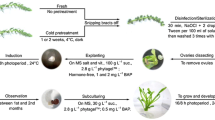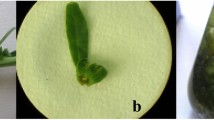Abstract
Induction of gynogenesis through ovule culture is a valuable tool to produce haploid and doubled haploid plants in sugar beet (Beta vulgaris L.). However, there is still large room for refining the method. In this study we investigated the gynogenic response of cultured ovules of three sugar beet genotypes, the effect of the application to inflorescences of different pretreatments with mannitol at 4ºC and with 5-azacytidine and 2,4-D, and the effect of the use of different basal culture media and sucrose concentrations. The response was evaluated in terms of percentages of induction of gynogenesis, embryogenesis and callogenesis, as well as of regenerated plants. We showed that a pretreatment with 0.5 M mannitol at 4 °C for 4 days, and with 50 µM 5-AzaC for 1 h, notably improved the percentage of embryogenesis and plant regeneration. Besides, the use of MS basal medium and 60 g/L sucrose was also found beneficial. This study provides new ways to improve the efficiency of haploid induction and plant regeneration through ovule culture in sugar beet, and is potentially applicable to ovule culture in other crops.
Key message
This study provides new ways to improve the efficiency of haploid induction and plant regeneration through ovule culture in sugar beet.




Similar content being viewed by others
References
Abdollahi MR, Rashidi S (2018) Production and conversion of haploid embryos in chickpea (Cicer arietinum L.) anther cultures using high 2, 4-D and silver nitrate containing media. Plant Cell Tiss Organ Cult 133:39–49
Aflaki F, Pazuki A, Gurel S, Stevanato P, Biancardi E, Gurel E (2017) Doubled haploid sugar beet: an integrated view of factors influencing the processes of gynogenesis and chromosome doubling. International Sugar Journal 119:884–895
Ardebili SH, Shariatpanahi ME, Amiri R, Emamifar M, Oroojloo M, Nematzadeh G, Sadat Noori SA, Heberle-Bors E (2011) Effect of 2, 4-D as a Novel Inducer of Embryogenesis in Microspores of Brassica napus L. Czech J Genet Plant Breed 47:114–122
Barański R (1996) In vitro gynogenesis in red beet (Beta vulgaris L.): effects of ovule culture conditions. Acta Soc Bot Pol 65:57–60
Bohanec B (2009) Doubled Haploids via Gynogenesis. In: Touraev AF, Forster BP, Jain SM (eds) Advances in Haploid Production in Higher Plants. Springer, pp 35–46
Chen JF, Cui L, Malik AA, Mbira KG (2011) In vitro haploid and dihaploid production via unfertilized ovule culture. Plant Cell Tiss Organ Cult 104:311–319
Corral-Martínez P, Seguí-Simarro JM (2012) Efficient production of callus-derived doubled haploids through isolated microspore culture in eggplant (Solanum melongena L.). Euphytica 187(1):47–61
Corral-Martínez P, Seguí-Simarro JM (2014) Refining the method for eggplant microspore culture: effect of abscisic acid, epibrassinolide, polyethylene glycol, naphthaleneacetic acid, 6-benzylaminopurine and arabinogalactan proteins. Euphytica 195(3):369–382
De Greef W, Jacobs M (1979) In vitro culture of the sugarbeet: description of a cell line with high regeneration capacity. Plant Sci Lett 17:55–61
Fraga HP, Vieira LN, Caprestano CA, Steinmacher DA, Micke GA, Spudeit DA, Pescador R, Guerra MP (2012) 5-Azacytidine combined with 2,4-D improves somatic embryogenesis of Acca sellowiana (O. Berg) Burret by means of changes in global DNA methylation levels. Plant Cell Rep 31:2165–2176
Grzybkowska D, Morończyk J, Wójcikowska B, Gaj MD (2018) Azacitidine (5-AzaC)-treatment and mutations in DNA methylase genes affect embryogenic response and expression of the genes that are involved in somatic embryogenesis in Arabidopsis. Plant Growth Regul 85:243–256
Gürel S, Gürel E, Kaya Z (2000) Doubled haploid plant production from unpollinated ovules of sugar beet (Beta vulgaris L.). Plant Cell Rep 19:1155–1159
Gürel S, Gürel E, Kaya Z, Erdal M, Güler E (2003) Effects of antimitotic agents on haploid plant production from unpollinated ovules of sugar beet (Beta vulgaris L.). Biotechnol Biotechnol Equip 17:97–101
Hassani M, Heidari B, Dadkhodaie A, Stevanato P (2018) Genotype by environment interaction components underlying variations in root, sugar and white sugar yield in sugar beet (Beta vulgaris L.). Euphytica 214:79
Klimek-Chodacka M, Baranski R (2013) Comparison of haploid and doubled haploid sugar beet clones in their ability to micropropagate and regenerate. Electron J Biotechnol 16:1–10
Leljak-Levanić D, Bauer N, Mihaljević S, Jelaska S (2004) Changes in DNA methylation during somatic embryogenesis in Cucurbita pepo L. Plant Cell Rep 23:120–127
Li H, Soriano M, Cordewener J, Muiño JM, Riksen T, Fukuoka H, Angenent GC, Boutilier K (2014) The histone deacetylase inhibitor Trichostatin A promotes totipotency in the male gametophyte. Plant Cell 26(1):195–209
Lipavska H, Vreugdenhil D (1996) Uptake of mannitol from the media by in vitro grown plants. Plant Cell Tiss Organ Cult 45:103–107
Lux H, Herrmann L, Wetzel C (1990) Production of haploid sugar beet (Beta vulgaris L.) by culturing unpollinated ovules. Plant Breed 104:177–183
Murashige T, Skoog F (1962) A revised medium for rapid growth and bio assays with tobacco tissue cultures. Physiol Plant 15:473–497
Nagl N, Mezei S, Kovačev L, Vasić D, Čačić N (2004) Induction and micropropagation potential of sugar beet haploids. Genetika 36:187–194
Nowaczyk L, Nowaczyk P, Olszewska D, Niklas-Nowak A (2015) Effect of 2,4-dichlorophenoxyacetic acid pretreatment of Capsicum spp. donor plants on the anther culture efficiency of lines selected by capsaicinoid content. Biotechnologia 96:179–183
Osorio-Montalvo P, Sáenz-Carbonell L, De-la-Peña C (2018) 5-Azacytidine: a promoter of epigenetic changes in the quest to improve plant somatic embryogenesis. Int J Mol Sci 19:3182
Parra-Vega V, Renau-Morata B, Sifres A, Seguí-Simarro JM (2013) Stress treatments and in vitro culture conditions influence microspore embryogenesis and growth of callus from anther walls of sweet pepper (Capsicum annuum L.). Plant Cell Tissue Organ Cult 112(3):353–360
Pazuki A, Aflaki F, Gürel E, Ergül A, Gürel S (2017) A robust method for haploid sugar beet in vitro proliferation and hyperhydricity reduction. Folia Hortic 29:241–250
Pazuki A, Aflaki F, Gürel E, Ergül A, Gürel S (2018a) Gynogenesis induction in sugar beet (Beta vulgaris) improved by 6-benzylaminopurine (BAP) and synergized with cold pretreatment. Sugar Tech 20:69–77
Pazuki A, Aflaki F, Gürel S, Ergül A, Gürel E (2018b) Production of doubled haploids in sugar beet (Beta vulgaris): an efficient method by a multivariate experiment. Plant Cell Tiss Organ Cult 132:85–97
Pazuki A, Aflaki F, Gurel S, Ergul A, Gurel E (2018c) The effects of proline on in vitro proliferation and propagation of doubled haploid sugar beet (Beta vulgaris). Turk J Bot 42:280–288
Salas P, Prohens J, Seguí-Simarro JM (2011) Evaluation of androgenic competence through anther culture in common eggplant and related species. Euphytica 182(2):261–274
Seguí-Simarro JM (2016) Androgenesis in solanaceae. In: Germanà MA, Lambardi M (eds) In vitro embryogenesis, vol 1359. Methods in Molecular Biology. Springer Science + Business Media, New York, pp 209–244
Shariatpanahi ME, Bal U, Heberle-Bors E, Touraev A (2006) Stresses applied for the re-programming of plant microspores towards in vitro embryogenesis. Physiol Plant 127:519–534
Testillano PS (2019) Microspore embryogenesis: targeting the determinant factors of stress-induced cell reprogramming for crop improvement. J Exp Bot 70(11):2965–2978
Tomaszewska-Sowa M (2010) Cytometric analyses of sugar beet (Beta vulgaris L.) plants regenerated from unfertilized ovules cultured in vitro. Electron J Pol Agric Univ 13:1–10
Yamamoto N, Kobayashi H, Togashi T, Mori Y, Kikuchi K, Kuriyama K, Tokuji Y (2005) Formation of embryogenic cell clumps from carrot epidermal cells is suppressed by 5-azacytidine, a DNA methylation inhibitor. J Plant Physiol 162:47–54
Yaseen M, Ahmad T, Sablok G, Standardi A, Hafiz IA (2013) Role of carbon sources for in vitro plant growth and development. Mol Biol Rep 40:2837–2849
Author information
Authors and Affiliations
Contributions
MRA conceived and designed the experiments. SS performed the experiments. SS, MRA, AMA, HEK and MA prepared reagents, materials and analytic tools. MRA, SS and JMSS analyzed the data and wrote the manuscript. All authors read and approved the final manuscript.
Corresponding author
Ethics declarations
Conflict of interest
The authors declare no conflict of interest.
Additional information
Communicated by Maria Antonietta Germanà.
Publisher's Note
Springer Nature remains neutral with regard to jurisdictional claims in published maps and institutional affiliations.
Rights and permissions
About this article
Cite this article
Sohrabi, S., Abdollahi, M.R., Mirzaie-Asl, A. et al. A refined method for ovule culture in sugar beet (Beta vulgaris L.). Plant Cell Tiss Organ Cult 146, 259–267 (2021). https://doi.org/10.1007/s11240-021-02065-8
Received:
Accepted:
Published:
Issue Date:
DOI: https://doi.org/10.1007/s11240-021-02065-8




